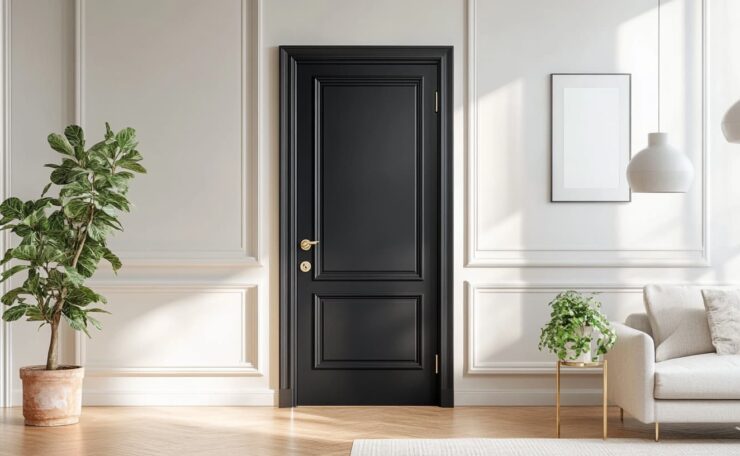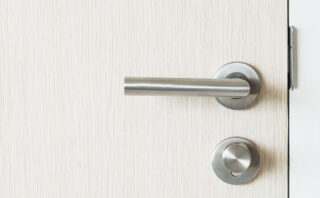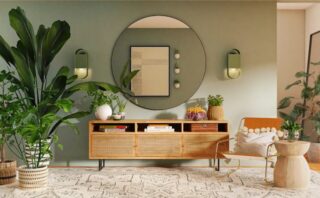Understanding Door Styles in Modern Home Design Trends
When planning a home renovation, doors are often overlooked. But they play a much bigger role than simply dividing rooms. Doors help define the look and feel of a space. The right style can add warmth, character, or sleek minimalism to your home, depending on your design direction.
In today’s market, homeowners have more door options than ever before. From clean-lined slab doors perfect for modern interiors to detailed panel designs that fit traditional spaces, your choice should reflect your overall renovation goals. Trends are moving toward customization—natural wood finishes, bold colors, glass inserts, and mixed materials all have their place in current design schemes.
Professional Coordination Between Door Selection and Overall Renovation Planning
One of the biggest mistakes homeowners make is treating doors as an afterthought. But door style, size, swing direction, and hardware all impact room layout, lighting, and traffic flow. That’s why it’s important to coordinate door choices early in the renovation process—not after the walls go up.
Working with experienced professionals helps tie everything together. Contractors like American Quality Remodeling, known for their full-service renovation work in New Jersey, understand how to integrate door choices with flooring, lighting, trim, and structural elements. They ensure door specs match framing requirements and aesthetic goals—so nothing feels like a mismatch or retrofit later.
Matching Door Materials with Your Renovation Aesthetic
Choosing the right door material isn’t just about function—it’s a design decision that shapes the entire look and feel of your home. The material affects texture, color depth, durability, acoustics, and even how natural light interacts with your space. Matching the material to your renovation style ensures a cohesive result that feels intentional, not pieced together.
Wood Doors for Traditional and Rustic Renovations
Solid wood doors are a timeless choice, especially for homes with warm, classic, or handcrafted aesthetics. They bring visual weight, natural texture, and a sense of permanence that works beautifully in traditional, farmhouse, craftsman, and rustic designs.
Woods like oak and maple offer tight grains and smooth finishes that stain evenly, while knotty alder and pine add character with natural imperfections and a more rustic look. Stains can be customized to match hardwood flooring, cabinetry, or ceiling beams, helping to tie rooms together visually.
Beyond looks, solid wood doors offer superior sound insulation, making them ideal for bedrooms, offices, and bathrooms. They also feel more substantial to the touch—a subtle cue of quality that many homeowners and guests notice immediately.
Pro tip: In high-humidity areas like bathrooms or laundry rooms, consider wood species that resist swelling and warping, or opt for engineered wood cores with veneer finishes to get the look without the maintenance risk.
Glass and Metal Options for Contemporary Designs
For homes with a modern or industrial vibe, glass and metal doors deliver clean lines and a lighter visual footprint. Full glass panels create a sense of openness and maximize light flow between rooms, ideal for open-concept layouts or compact homes that need to feel larger.
Frosted, reeded, or tinted glass provides privacy without sacrificing daylight, making it a smart choice for bathrooms, offices, or any space that needs separation without feeling closed off.
Aluminum and steel-framed doors work well in minimalist or loft-style spaces, pairing seamlessly with exposed brick, concrete floors, or matte black finishes. Black-framed glass doors, in particular, are a favorite in contemporary renovations for their crisp geometry and high contrast.
Frameless sliding glass systems or pivot doors can further elevate modern aesthetics, offering functionality and architectural interest. Just be mindful of fingerprints and cleaning—glass doors require regular maintenance to keep them looking sharp.
Composite Materials for Versatile Modern Styles
Composite doors are engineered for versatility. Made from a mix of wood fibers, resins, and other synthetics, they’re durable, cost-effective, and available in almost any style or finish. For homeowners who want the visual appeal of wood without the upkeep, composites are a strong option.
You’ll find wood-look veneers that mimic oak, walnut, or birch with surprising realism—often paired with a smoother, more consistent surface than real wood. Matte finishes in white, gray, or black make it easy to match modern palettes. Some models even offer integrated patterns or textures that add dimension.
Composite doors are resistant to warping, moisture, pests, and cracking, which makes them ideal for bathrooms, basements, or exterior entries. Many are also hollow-core or solid-core with a foam or engineered wood center, giving you options depending on budget and soundproofing needs.
In homes where you’re mixing traditional and modern elements—say, a historic home with a modern kitchen—composite doors provide the flexibility to bridge different styles without clashing.
Color Coordination and Hardware Selection Strategies
Choosing Door Colors That Enhance Room Flow
Color isn’t just a design choice—it’s a tool. Doors painted in complementary shades can help guide visual flow from room to room. Neutral tones like white, gray, and taupe are timeless, but don’t be afraid to go bold in the right space. Deep blues, charcoal blacks, or even forest green doors can create contrast and drama, especially when paired with clean wall colors and modern trim.
Consistency is key. Matching door colors to your baseboards, window casings, or cabinetry ensures a cohesive look throughout the home. If you’re using accent doors—like a black barn door in a white kitchen—make sure it ties into other black elements, such as lighting fixtures or hardware.
Hardware Finishes That Complement Other Fixtures
Door hardware should feel like a natural part of the home—not an afterthought. Matte black handles pair beautifully with industrial or contemporary interiors. Brushed nickel works well in transitional spaces. For more warmth, brass and bronze finishes are back in style, especially in rustic or mid-century homes.
To maintain consistency in the design, match your door hardware to the cabinet pulls, light fixtures, and faucet finishes. This subtle detail helps unify the space and signals thoughtful design planning.
Balancing Bold Statement Doors with Neutral Spaces
Statement doors—whether brightly colored, textured, or oversized—can be a powerful design element. But they work best when balanced by simpler surroundings. A bold door in a neutral hallway becomes a focal point. In contrast, using too many standout elements can make a space feel chaotic.
If you’re going with a statement door, let it breathe. Avoid busy patterns or competing features nearby. Think of it as the anchor of the room—not just a functional object.
Functional Considerations in Door Design Integration
Privacy Requirements and Door Style Selection
Some rooms, such as bedrooms, bathrooms, and home offices, require solid-core doors for added privacy. Others benefit from partial transparency or openness, such as glass panel doors in dining areas or kitchens. Pocket doors and barn doors are great options where space is limited, but they may not provide full acoustic or visual privacy. Know the needs of each room before making your selection.
Space-Saving Solutions for Small Home Renovations
In compact homes, swinging doors can waste precious square footage. Sliding, folding, or pocket doors can reclaim that space. These options provide more flexibility in furniture layout and reduce traffic congestion in tight areas, such as hallways, closets, or small bathrooms.
Accessibility Features in Modern Door Design
More homeowners are planning to age in place or making their homes friendlier for all users. Wider doorways, lever handles, and smooth threshold transitions make homes more accessible without compromising design. ADA-compliant doors are now available in a range of styles, proving that function and aesthetics can go hand in hand.
Budget-Friendly Ways to Upgrade Existing Doors During Renovation
Not every renovation requires tearing everything out and starting from scratch. In fact, one of the most cost-effective ways to refresh your interior is by upgrading the doors you already have. With a bit of creativity and the right materials, even the most basic doors can be transformed into design assets.
Paint: The Fastest, Most Impactful Upgrade
A simple fresh coat of paint can change everything. Whether you go for classic white, soft neutrals, or bold contrast colors like navy, black, or emerald green, painting a door is one of the easiest ways to bring new life to a room. Try high-gloss finishes for a modern edge or matte for a more understated, architectural look.
Don’t forget to prep properly—sanding and priming are key to getting a smooth, professional result, especially on older or laminated doors.
Hardware Swaps That Make a Big Difference
Replacing door handles, hinges, and strike plates instantly modernizes any door. Swap dated brass knobs for matte black levers, or go with brushed nickel or antique bronze, depending on your home’s overall style. Don’t overlook the power of matching door hardware to nearby fixtures like cabinet pulls and lighting—it creates a pulled-together, designer feel.
Upgrading to soft-close hinges, magnetic latches, or concealed hardware also enhances the door’s functionality, not just its appearance.
DIY Trim, Paneling, and Molding
For flat or hollow-core doors, adding trim or molding is a high-impact, low-cost way to mimic expensive solid-panel designs. Use thin MDF or pine strips to create shaker-style panels, grids, or picture-frame layouts. Once caulked and painted, the door takes on a custom, built-in appearance.
Pre-cut trim kits are available at most hardware stores and can be installed in the afternoon with minimal tools. It’s a great solution for rental properties or flips where you want to elevate finishes on a budget.
Refinishing Instead of Replacing
If the door is solid but just looks worn or outdated, refinishing it can bring out its original character. Strip old paint or stain, sand the surface smooth, and apply a new finish to suit your updated interior. Natural wood grain, once exposed and treated, adds warmth and texture that’s hard to replicate with new materials.
This approach is not only budget-friendly, but it’s also sustainable. Reusing and restoring what you already have reduces construction waste and keeps materials out of landfills.
Add Functionality Without Replacing the Door
If you’re working with a tight space or want to add more utility, consider enhancing your existing door with new features. Install a full-length mirror, add a chalkboard panel in a pantry, or mount coat hooks or storage baskets on the back of a closet door.
You can also switch to barn door hardware or bifold tracks if you want to change how the door operates without altering the structure. These options can save space and add character while keeping costs low.
Common Mistakes to Avoid When Selecting Doors for Your Project
One common mistake is choosing door styles that clash with the rest of the renovation. A sleek glass door might look great on its own—but it won’t make sense in a farmhouse kitchen with distressed wood cabinets.
Another pitfall: not factoring in door swing or clearance. Doors that bump into furniture or block traffic flow create daily frustration. Always measure carefully and think ahead.
And finally, avoid cheap hardware. It might save a few dollars upfront, but low-quality knobs and hinges wear out quickly and make even a beautiful door feel flimsy. Invest in durable, well-finished components—they’ll elevate the entire space.



